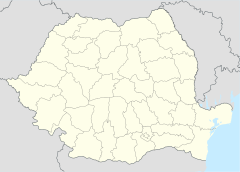Movile Cave
Coordinates: 43°49′32″N 28°33′38″E / 43.825694°N 28.560556°E
| Movile Cave | |
|---|---|
| Romanian: Peștera Movile | |
| Location | Near Mangalia, Constanța County, Romania |
| Coordinates | 43°49′32″N 28°33′38″E / 43.825694°N 28.560556°E |
| Discovery | 1986 |
| Entrances | 1 (artificial) |
| Hazards | Hypoxic atmosphere, with dangerous levels of carbon dioxide, hydrogen sulfide, and ammonia |
| Features | Naturally sealed cave containing unique ecosystem supported by chemosynthesis |


Movile Cave (Romanian: Peștera Movile) is a cave near Mangalia, Constanța County, Romania discovered in 1986 by Cristian Lascu a few kilometers from the Black Sea coast.[1] It is notable for its unique groundwater ecosystem abundant in hydrogen sulfide and carbon dioxide, but low in oxygen. Life in the cave has been separated from the outside for the past 5.5 million years and it is based completely on chemosynthesis rather than photosynthesis.[1]
Chemical environment[]
The air in the cave is very different from the outer atmosphere. The level of oxygen is only a third to half of the concentration found in open air (7–10% O2 in the cave atmosphere, compared to 21% O2 in air), and about one hundred times more carbon dioxide (2–3.5% CO2 in the cave atmosphere, versus 0.04% CO2 in air). It also contains 1–2% methane (CH4) and both the air and waters of the cave contain high concentrations of hydrogen sulfide (H2S) and ammonia (NH3).[2]
Biology[]
The cave is known to contain 57 animal species,[3][4] among them leeches, spiders, pseudoscorpions,[5] woodlice,[6] a centipede,[7] a water scorpion (),[8] and also a snail.[9] Of these, 37 are endemic.[3][4] The food chain is based on chemosynthesis in the form of methane- and sulfur-oxidizing bacteria, which in turn release nutrients for fungi and other bacteria. This forms microbial mats on the cave walls and the surface of lakes and ponds which are grazed on by some of the animals. The grazers are then preyed on by predatory species.[10] Nepa anophthalma is the only known cave-adapted water scorpion in the world.[8] While animals have lived in the cave for 5.5 million years, not all of them arrived simultaneously. One of the most recent animals recorded is the cave's only species of snail, Heleobia dobrogica, which has inhabited the cave for slightly more than 2 million years.[5][1][9]
See also[]
References[]
General references[]
- Jean Balthazar: Grenzen unseres Wissens. Orbis Verlag, München 2003, Seite 268, ISBN 3-572-01370-4.
- Sarbu, Serban M.; Kane, Thomas C.; Kinkle, Brian K. (28 June 1996). "A Chemoautotrophically Based Cave Ecosystem". Science. 272 (5270): 1953–1955. doi:10.1126/science.272.5270.1953. PMID 8662497. S2CID 23842700.
- Wischer, Daniela; Kumaresan, Deepak; Johnston, Antonia; El Khawand, Myriam; Stephenson, Jason; Hillebrand-Voiculescu, Alexandra M; Chen, Yin; Colin Murrell, J (January 2015). "Bacterial metabolism of methylated amines and identification of novel methylotrophs in Movile Cave". The ISME Journal. 9 (1): 195–206. doi:10.1038/ismej.2014.102. PMC 4274414. PMID 25050523.
Inline citations[]
- ^ a b c Fox-Skelly, Jasmin (4 September 2015). "The bizarre beasts living in Romania's poison cave". BBC Earth.
- ^ Kumaresan, Deepak; Wischer, Daniela; Stephenson, Jason; Hillebrand-Voiculescu, Alexandra; Murrell, J. Colin (16 March 2014). "Microbiology of Movile Cave—A Chemolithoautotrophic Ecosystem". Geomicrobiology Journal. 31 (3): 186–193. doi:10.1080/01490451.2013.839764. S2CID 84472119.
- ^ a b GESS Lab. (2020). Movile Cave - a unique ecosystem. Gesslab. https://www.gesslab.org/movile-cave
- ^ a b GESS Lab. (2020a). List of invertebrate species encountered and described in the Movile Cave ecosystem. https://fecc112f-3776-4476-a602-1572b7478186.filesusr.com/ugd/1e4de5_ebb50699a75848bbb0c3f12a65da4c5d.pdf
- ^ a b Nag, Oishimaya Sen (25 April 2017). "Movile Cave - An Oddity Of Romania". WorldAtlas.
- ^ Karen Graham: Movile Cave in Romania has an ecosystem unlike any other on Earth. In: DigitalJournal. 25 May 2016. Source: Science
- ^ Varpu Vahtera, Pavel Stoev, Nesrine Akkari: Five million years in the darkness: A new troglomorphic species of Cryptops Leach, 1814 (Chilopoda, Scolopendromorpha) from Movile Cave, Romania. On: ZooKeys 1004: pp 1-26. doi:10.3897/zookeys.1004.58537 (16 December 2020). See also:
- David Nield: Meet The 'King' of a Toxic Underground Ecosystem Unlike Anywhere Else on Earth. On: sciencealert. 19 December 2020. About , the cave dwelling sister species of C. hortensis, Cryptopidae
- New Centipede Discovered on Top of Food Chain in Hellish Ecosystem of a Sulfur-Soaked Romanian Cave. On: SciTechDaily. December 16, 2020
- ^ a b Decu, Vasile; Gruia, Magdalena; Keffer, S. L.; Sarbu, Serban Mircea (1 November 1994). "Stygobiotic Waterscorpion, Nepa anophthalma, n. sp. (Heteroptera: Nepidae), from a Sulfurous Cave in Romania". Annals of the Entomological Society of America. 87 (6): 755–761. doi:10.1093/aesa/87.6.755.
- ^ a b Andrzej Falniowski, Magdalena Szarowska, Ioan Sirbu, Alexandra Hillebrand, Mihai Baciu: Heleobia dobrogica (Grossu & Negrea, 1989)(Gastropoda: Rissooidea: Cochliopidae) and the estimated time of its isolation in a continental analogue of hydrothermal vents. In: Molluscan Research 28(3): pp 165-170. 22 Dec 2008. ISSN 1323-5818
- ^ "Microbial food webs in Movile Cave". UK Research and Innovation.
External links[]
- Caves of Romania
- Geography of Constanța County
- Ecosystems
- Endemism
